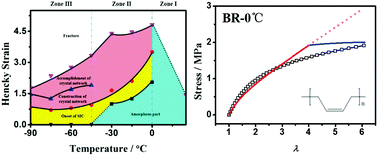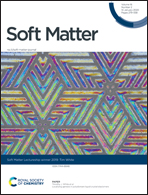Reconstructing the mechanical response of polybutadiene rubber based on micro-structural evolution in strain-temperature space: entropic elasticity and strain-induced crystallization as the bridges†
Abstract
Strain-induced crystallization (SIC) in polybutadiene rubber (BR) was studied by in situ synchrotron radiation wide-angle X-ray diffraction (SR-WAXD) over a broad temperature range (−90 °C → 25 °C). Depending on the presence or absence of SIC and quiescent crystallization temperature, three temperature regions are divided. Detailed structural evolution is summarized in the strain-temperature space. Based on this micro-structural evolution information, the macroscopic mechanical response of BR, together with poly(isobutylene-isoprene) rubber (IIR) and natural rubber (NR), is reproduced based on Flory's and Plagge's theories. The origins of the mismatch of calculated and experimental stress–strain curves, especially in the large strain region, are discussed, and are mainly ascribed to the micro-macro connection approach and the network inhomogeneity.



 Please wait while we load your content...
Please wait while we load your content...